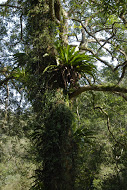
Machilus-Castanopsis are plants belonging to the Lauraceae and Fagaceae families. At attitudes ranging from 500 to 1800 m, they are important constituents as well as the most advantageous species in the Fushan forest. The seeds, sprouts, and leaves of many species under these families are main source of food for gnawing animals.
Due to the plenty rainfall and high air humidity in here, numerous epiphytes, higher plants that do not root on soil but grow upon or attach to another living plant. Some examples of commonly seen epiphytes include: Asplenium antiquum, Pseudodrynaria coronans, Dischidia formosana, and some species of Orchidaceae family.
The garden itself was originally designed according to Engler's phylogenic system, by which the plants are divided into the following 5 groups, gymnosperm, polypetalous, sympetalous, ericaceae and bamboo.
- Gymnosperm, a group of vascular plants which is flowering, seeding with exposed ovule but not covered in ovary.
- Polypetalous flower plants are plants whose flowers have separate petals and wilt fall to the ground piece by piece.
- Sympetalous flowers are plants whose flower petals are connected to each other.
- Ericaceae are azaleas and rhododendrons. They are warm flowers which come in different colors.
- Bamboo is the largest member of the grass family. It is also the most represented plant in the monsoon zone of Asia.


